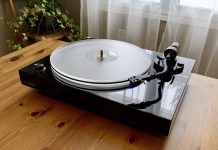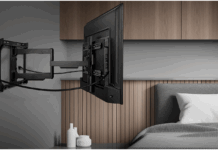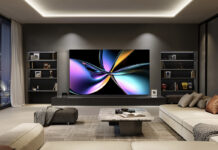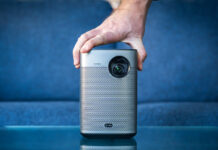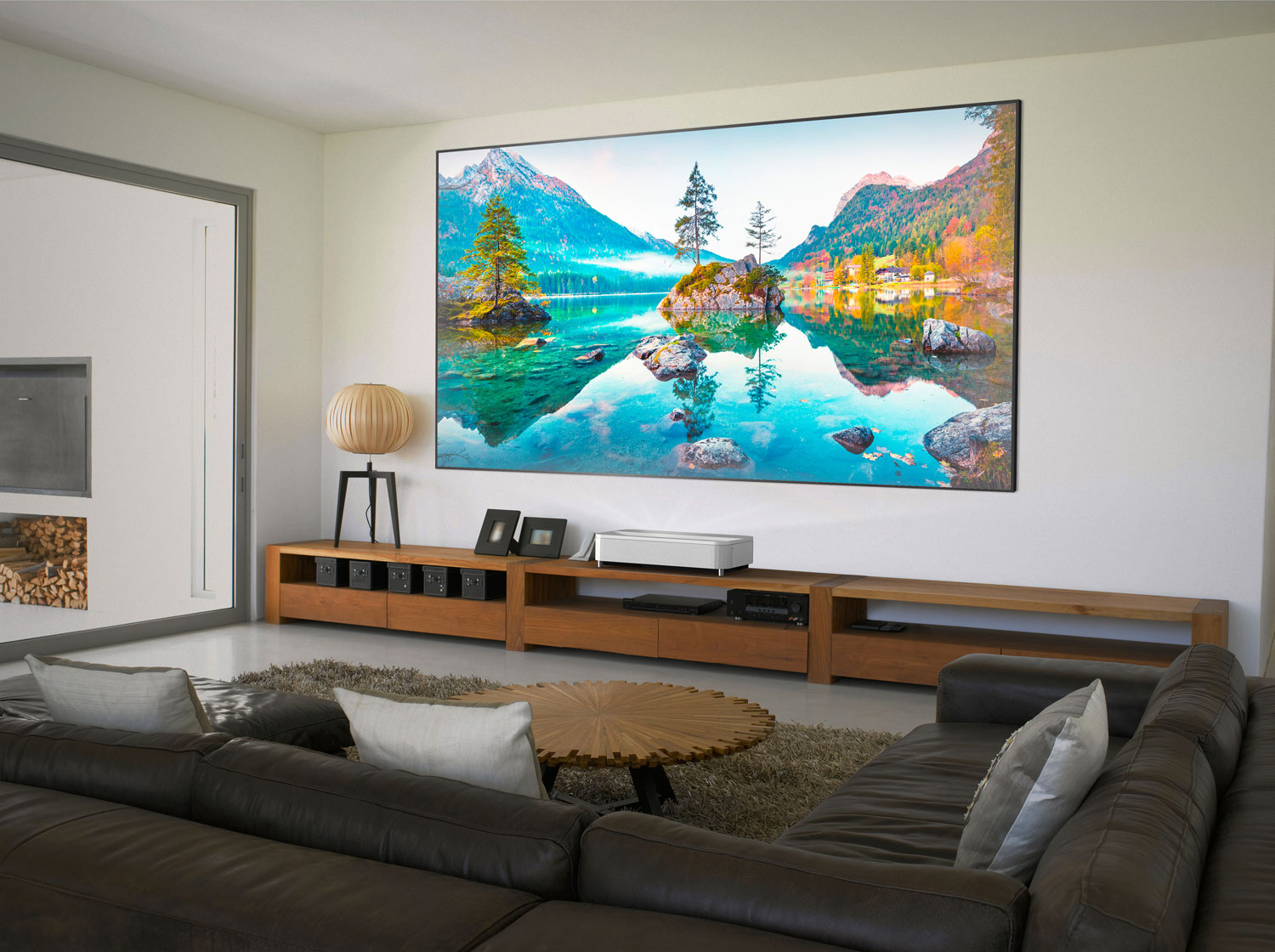
There was a time when projectors were mainly used in classrooms and boardrooms. But today’s projectors are incredibly versatile—perfect for home theatres, outdoor movie nights, business presentations, and even gaming. Whether you’re looking to transform your living room into a cinema or take your favorite TV shows on the go, there’s a projector to suit your lifestyle.
This guide will walk you through everything you need to know about buying a projector: the types available, how they work, important features to consider, and which projector fits your needs best.
Table of contents
- Types of projectors
- LCD and DLP projectors
- Common light sources for projectors
- Key terms for projector technology
- Projectors that make great gifts
Main types of projectors and their ideal uses
Understanding the main categories of projectors can help you narrow down your options. You should first consider how the projector will be used most of the time to help you decide which model is right for you.
1. Home theatre projectors
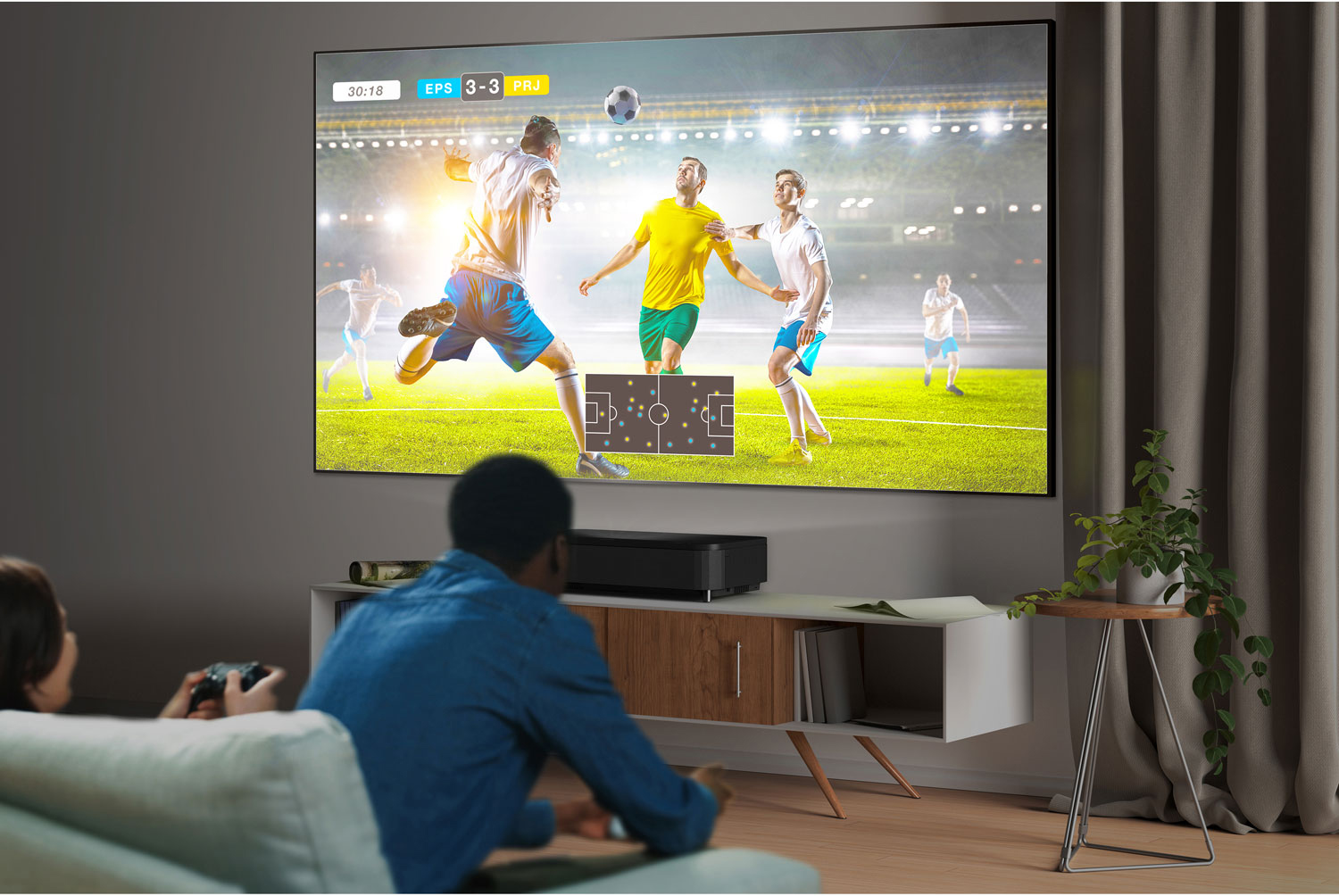
Home theatre projectors are designed for movie lovers and binge-watchers who want a cinematic experience at home. Modern home theatre projectors deliver 1080p or 4K resolution with vivid colours, deep contrast, and quiet operation. Look for models with built-in streaming platforms, multiple input options, and built-in Wi-Fi for seamless integration with your home entertainment system.
Home theatre projectors are most often recommended for:
- Streaming TV
- Movie nights
- Gaming
- Photo presentations or slideshows
2. Business or data projectors
Business projectors are meant to be used in large spaces, so they need to be powerful and bright. In fact, data or business projectors are often brighter than home theatre projectors because they often need to compensate for overhead lighting or windows in some large meeting spaces.
Business projectors often easily connect to laptop computers, either via cables such as HDMI, or Wi-Fi so that sharing presentations or files is easy. Because they’re used in remote or out-of-office locations, a business projector is often portable.
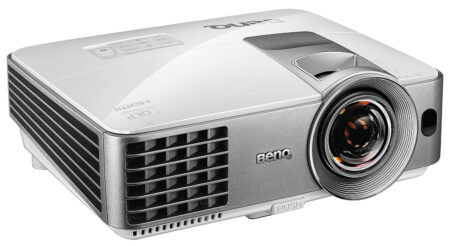
Business/Data projectors are most often recommended for:
- Classrooms
- Presentations in large spaces
- Conferences
- When displaying PowerPoint-style or data and info presentations
- People who need a portable solution for displays
3. Gaming projectors

A gaming projector is similar to a home theatre projector, but just like a gaming TV, a gaming projector focuses on features designed to give you the best gaming experience possible.
Gaming projectors project huge, vibrant images in 1080p or 4K resolution. Some models have HDR compatibility, and you’ll find that most gaming projectors run at at least 60Hz refresh rate. They have extremely low input lag and speedy response times, so you can enjoy gaming on a truly big home screen.
Gaming projectors are most often recommended for:
- Gamers who want a big-screen experience
- Families who’d like to game together
4. Portable projectors
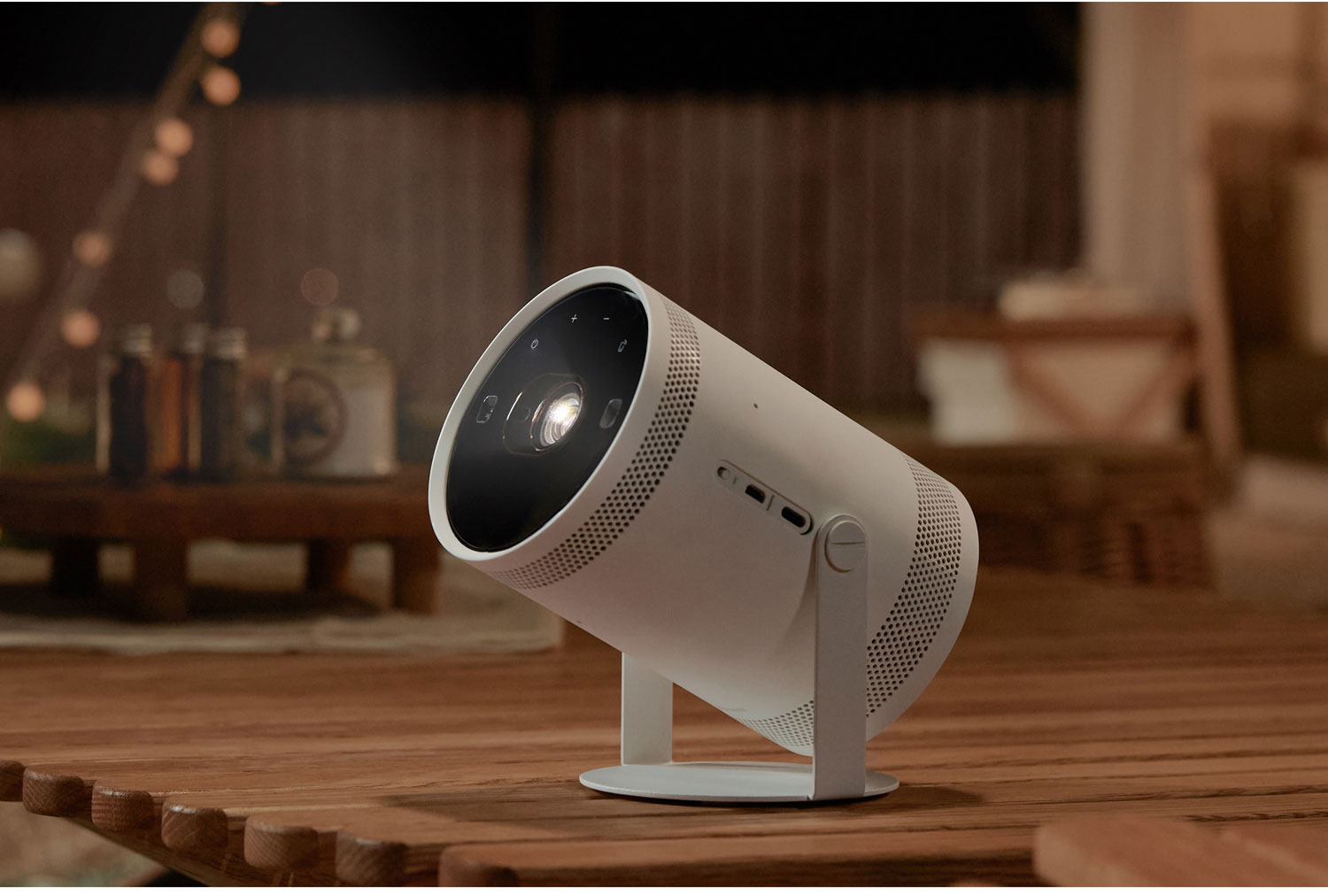
If you’re looking for a projector with the picture quality of a home theatre projector but in a take-anywhere, versatile package, you’re going to love portable projectors. With the launch of Samsung The Freestyle, a new class of projector is available for anyone who wants to take a home theatre quality projector on the go.
Samsung The Freestyle weighs less than 2 lbs, but this powerful projector streams in 1080p Full HD, has auto-focus and auto-levelling, and can project from 30 to 100 inches on any flat surface you have. It has Wi-Fi, Bluetooth, and you can control it with your voice assistant. Because it has 180-degree vertical adjustment you can point it straight up at the ceiling, down at the floor, or set it up at any angle.
With a 360-degree five-watt speaker, this portable projector can create a dance party in your living room. You can take it with you camping, set it up in your kid’s room, or use it to create a light show in your backyard.
5. Pico projectors
If you’re looking for a very small portable projector, pocket or Pico projectors are tiny pocket-sized projectors perfect for the businessperson on the go. They will fit easily into a handbag, carry-on, or briefcase and often weigh less than 3 pounds. Despite the small size, pocket projectors can display images up to 70 inches.
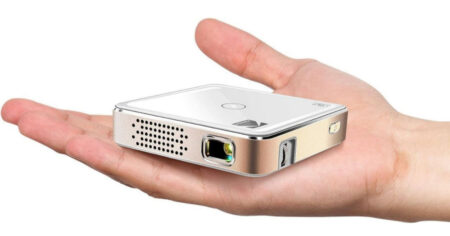
Pico projectors tend not to be as bright as full-size models, but they are often ‘smart”, connecting easily to Wi-Fi for use with cloud storage or streaming. You can also connect a pico model to a compact camera, smartphone or tablet, or laptop, giving you versatility in a very small package.
Pico projectors are most often recommended for:
- Small groups or small rooms
- Personal and travel use
You may also hear about one other type of projector, that encompasses a couple of the points noted earlier: the multi-use projector. Multi-use projectors often have the ability to be used as both a data projector for business applications and presentations, but also as a home theatre projector, allowing you to also use it for movies, gaming, and other home entertainment.
6. Short throw projectors
If you’d like to put your projector in your living room or bedroom but you’re short on space, a short throw projector may be the right choice for you. The main difference between a short throw projector vs a long throw projector is how far away the projector needs to be placed to ‘throw’ the image.
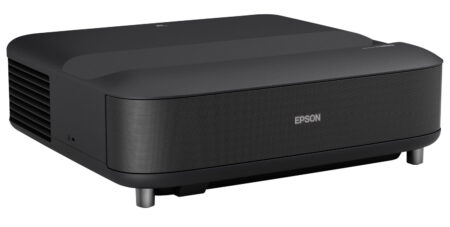
A long throw projector needs approximately 6 feet or more between where your projector is mounted and the projector screen. A short throw projector needs only half that distance to project the same image. There are also ultra-short throw projectors that can project a 100-inch image when it’s placed directly under, over, or in front of the screen.
There are many benefits to having a short throw projector. They work well in bright rooms so you will have no problem watching TV during the day. With the projector placed so close to the screen, you won’t notice the bright light of the bulb. You’ll find there are also fewer shadows produced on the screen because the throw distance is shorter.
If you choose a short throw projector or an ultra short throw projector, you’ll want to keep in mind that this type of projector works best with an ambient light rejecting projector screen. This type of screen is the best option for a short throw projector because it has an angular reflective surface that rejects ambient light while reflecting light from the projector to the screen.
7. Outdoor projectors
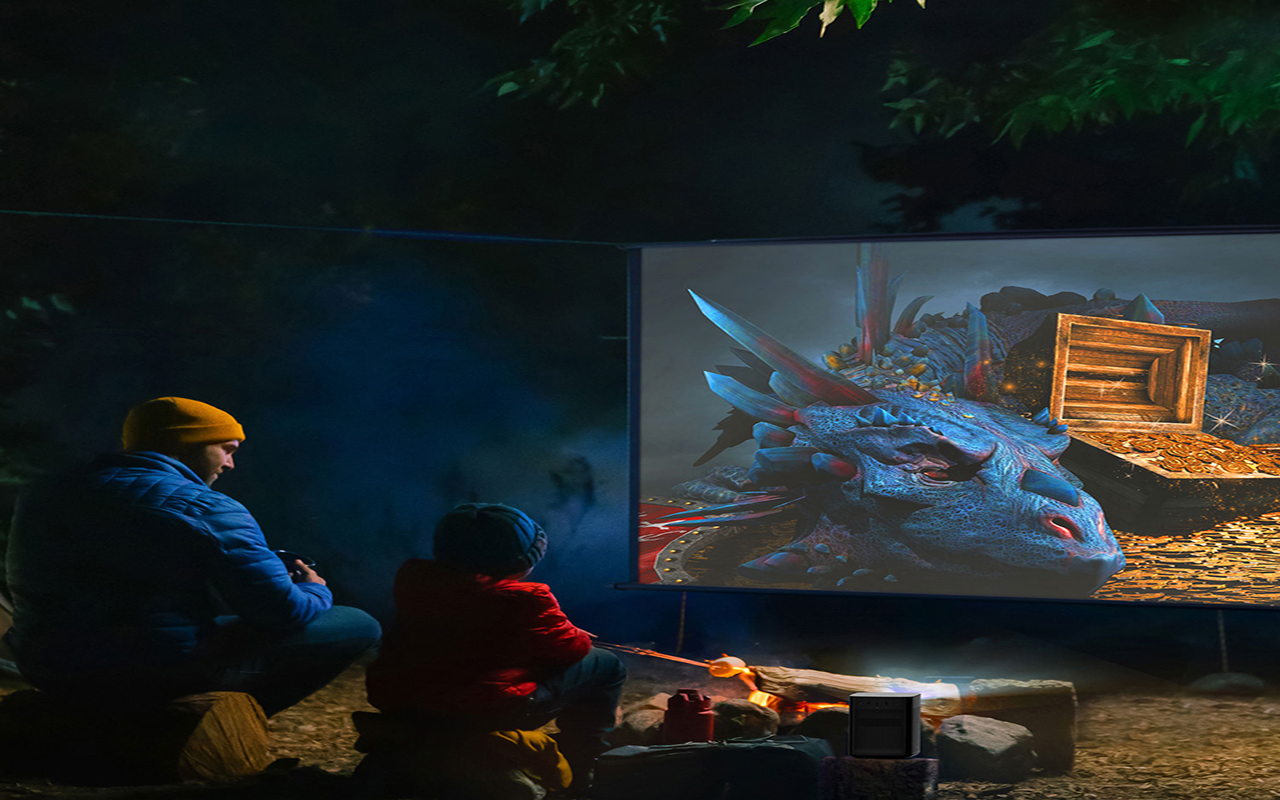
Many people love projecting movies outside for that theatre under the stars experience. Most projectors can be set up outdoors in a pinch: use them indoors or outdoors as needed. However, you can also find dedicated outdoor projectors.
This type of projector has a brighter light and is portable so you can set it up anywhere. It’s best viewed using an outdoor screen. One thing to keep in mind when using a projector outdoors is that projectors are not waterproof or water-resistant. You’ll need to avoid using it in inclement weather or near water, and you will always want to bring it inside when not in use.
You’ll also find that projectors work best in dark or dim light. They are great for outdoor movie nights on the patio, but if your goal is to stream a movie during the day, you’ll have a hard time seeing video or images in bright light.
Projector display technology: LCD and DLP
There are two main technologies used to project an image onto a screen: LCD and DLP.
LCD projectors
LCD, or “Liquid Crystal Display” is basically the same technology used in flatscreen TVs. In a television, lights bounce off liquid crystals to create a coloured image. In LCD projectors, light is beamed through liquid crystals on its way to the screen or wall.
LCD projector advantages:
◦ Brighter output makes it ideal for use in well-lit rooms
◦ Excellent colour brightness
◦ Sharper images for improved graphs and data on screen
◦ Displays crisp, clear 3D images with no “ghosting”
DLP projectors
DLP or Digital Light Processing, uses millions of tiny mirrors, or “digital micromirrors” to reflect light and beam an image. In DLP projectors, light projected through each mirror acts to reflect a pixel of the final image.
DLP advantages:
◦ Lightweight and compact (especially for compact, or “pico” models)
◦ Gives a more Hollywood-like picture when using Blu-ray, DVD, or HDTV
◦ Provides deeper, truer blacks when compared to LCD projectors
◦ Superior colour contrast
◦ Smooth motion for videos and fast-action scenes
Smart and streaming-ready projectors
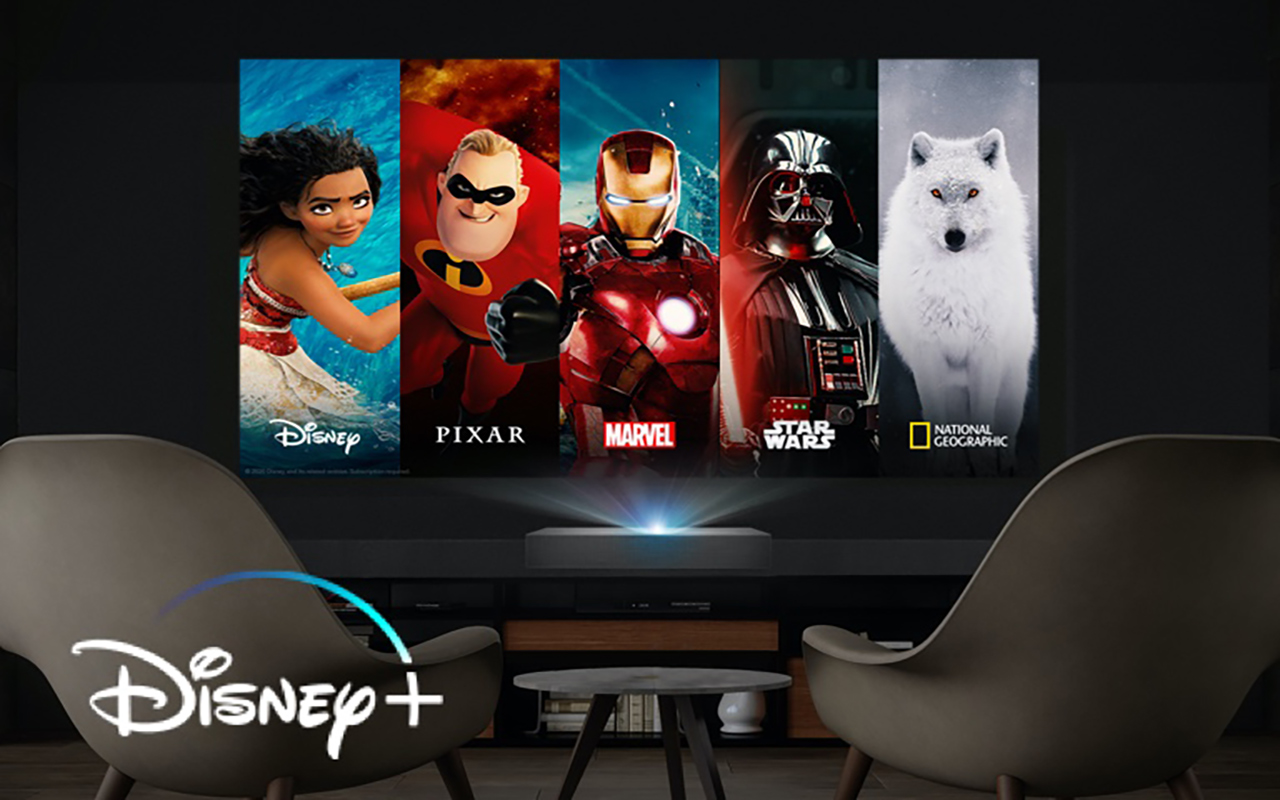
The latest 4K projectors offer 4K resolution and built-in Wi-Fi or Bluetooth. That means you can use this type of home theatre projector as an alternate to a TV, and you can even choose projectors with streaming services already on board. In this case, the setup and cable management are simplified since you will not have to plug in a streaming device or need an additional cable to power that device.
Some types of streaming projectors have a hub with Android TV features built-in, so you can stream your favourite movies and TV shows on apps like Netflix or YouTube. And, as stated above, even without built-in streaming or Android, most projectors enable you to connect a media streaming device to stream content.
Projector light sources: Lamp, LED, and laser
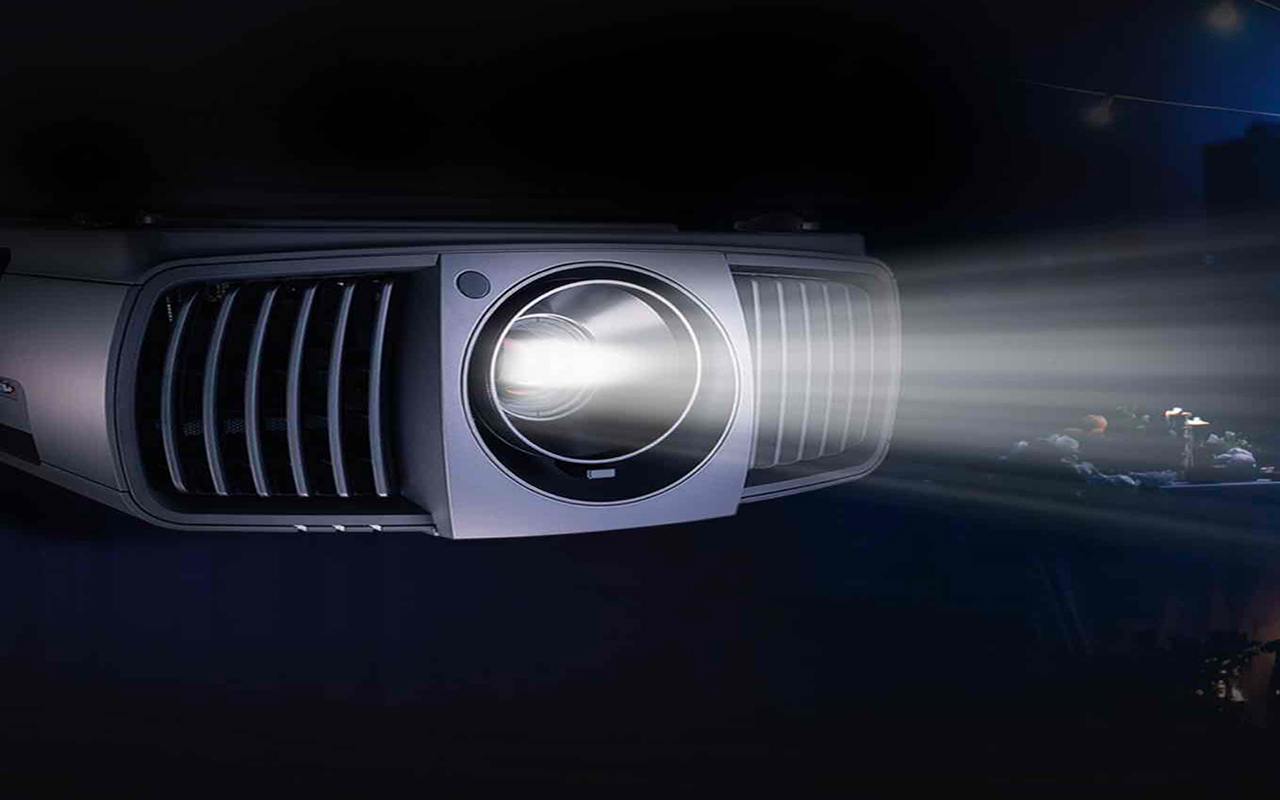
How bright is your projector bulb? It depends on what type of light source it has.
Lamp or bulb projector
Lamps or bulbs are the way projectors in years past operated. While a bulb can be very bright and can last thousands of hours, there are other advances in projector light technology that will give you a stronger and more reliable light option.
LED projector
LED is a subcategory of bulbs. LED projectors provide light without the same heat as regular bulbs, meaning a large noisy fan isn’t needed to keep the projector cool. LED bulbs also last much longer than traditional bulbs, singing for up to 20,000 hours compared to a traditional bulb’s 3-4,000 hour lifespan.
Laser projectors
Laser projectors use a technology that does away with bulbs altogether. Lasers provide a very bright illumination source and better contrast than a bulb. Laser projectors are also much more energy-efficient than either regular or even LED bulbs, and because they run cooler, projectors using laser light can be much less noisy.
Important projector specs and terms to know
Before you choose your new projector, there are a few terms to know.
Lumens (brightness)
Projector brightness is measured in ‘lumens’. The higher the number of lumens, the brighter the image will be. Most projectors now use about 2300 lumens minimum, but you’ll find projectors as bright as 7000 lumens.
Throw ratio
Throw ratio determines how far the projector must be from the screen to achieve a certain image size. Throw ratio is most important when mounting the projector or putting it in a fixed location since you’ll need to ensure the projector is at the right distance from the wall or screen to display properly. A short-throw projector is the best option if you won’t be using it in a fixed location.
Throw Ratio is calculated by looking at throw distance per foot of image width (Throw Distance: Image Width). A 2:1 throw ratio translates to 2 feet of throw distance per foot of screen width, meaning that to get a 7-foot wide image, the projector needs to be 14 feet from the screen.
Resolution
Resolution in projectors is quite similar to resolution in TVs. It is the total number of pixels that a projector is able to display, ranging from 480p, 720p, 1080p (HD), and 4K.
Choosing the right resolution is about more than going for the biggest number of pixels. It makes sense to also choose the resolution that will match the format being displayed most often. Whether that’s matching the resolution on a computer monitor (like XGA), or choosing a 4K projector for best watching Hollywood flicks, think about how the projector will most often be utilized and choose the proper resolution for that situation.
Contrast ratio
Contrast ratio measures the difference between the lightest areas of the image and the darkest. What that means in practical terms is that it allows viewers to see light and shadow, providing a depth of the picture and much more realism. A low contrast ratio means a more ‘washed out’ picture.
Light bleeding into the display space can affect how contrast is seen. In dark rooms, for example, the contrast will be more noticeable. In that case, a projector with a higher contrast ratio would be better. On the other hand, a brightly lit presentation or convention space will mean contrast is less noticeable, so it’s not usually as important to show such fine detail when it comes to contrast.
Keystone correction
When presenting in a space with walls that are not flat and square, or if placing the projector at a 90-degree angle to the screen or surface isn’t an option, look for a projector with “keystone correction”. Keystone Correction compensates for displaying at slight angles or projecting on curved surfaces by adjusting for those warped or distorted images digitally.
Do you need a projector screen?
Wherever you’re displaying your image, whether it’s at home or at the office, having a proper screen to project onto results in the highest quality image. While a white wall can be an acceptable canvas in a pinch, a proper screen will display the video to its best advantage.
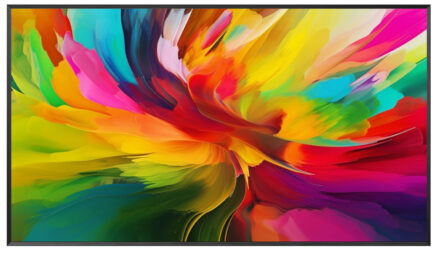
Projector screen options
Pull down screen (fixed or manual)
A screen with a self-locking mechanism gives you the most options for display. Rather than just pulling into one or two positions, a self-locking projector screen can be unrolled to almost any position.
Retractable screen
Retractable screens are best for permanent installation, so they are ideally used in a home theatre. When not in use, the screen retracts into the ceiling and slides into a casing designed to lie flat and be nearly invisible.
Portable/collapsible screen
This type of screen is best for travel. These screens come with tripod legs and a retractable screen that can be assembled in minutes.
Projectors that make great gifts
If you know someone who would love to have a projector for watching movies at home or to take with them on the go, there are a few types of projectors that are perfect for gifting.
If you’re buying a gift for someone who loves to camp or travel
Camping under stars is a lot of fun. If you know someone who spends a lot of time in a camper trailer or fifth wheel in the summer, you can give them the gift of a portable projector or outdoor projector. You’ll want to choose a projector with an LED light source and a minimum of 7500 lumens. You’ll find quite a few options with 1080p or 4K resolution so image quality will be colourful and detailed in variable light conditions.
For camping or traveling it’s a good idea to choose a projector with a slot for a SD memory card and Bluetooth so they don’t need to rely on a Wi-Fi connection to watch movies. It’s also a good idea to look for a projector with built in speaker so the audio will be crisp and clear.
If you’re buying a projector for someone who loves movies
Movie fans love the idea of recreating the big screen, movie theatre experience at home. With a laser projector or home theatre projector your gift recipient will be able to watch movies on screens up to 130 inches. The picture quality will be ultra-bright and bursting with vibrant colour, and they will be able to watch at night or during the day because the projector will be bright enough to handle all conditions.
If you’re buying a projector for kids
Pico projectors are a good choice for kids. They can snuggle up in a blanket fort in their room and watch their favourite TV shows or movies on their wall. A pico projector usually has Wi-Fi on board so they can connect their tablet or phone to the projector and stream their own video. It’s also small enough to put in a backpack and take along to sleep overs.
Whether you’re watching movies under the stars, gaming on a massive screen, or presenting in a boardroom, there’s a projector that fits your lifestyle and space. With this guide, you’re well-equipped to find the one that’s right for you. Head over to BestBuy.ca to explore a wide selection of projectors for your home, business, or entertainment needs.



